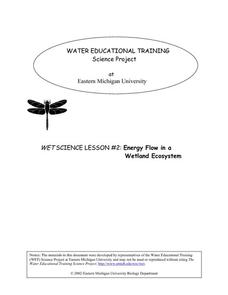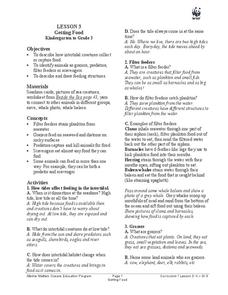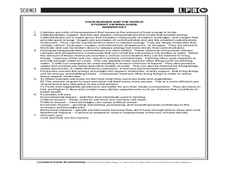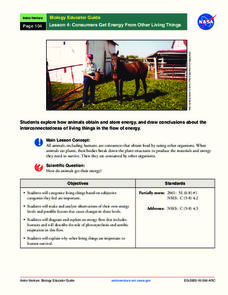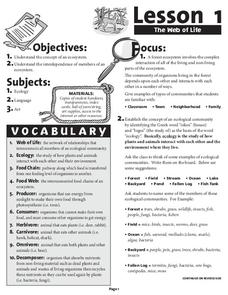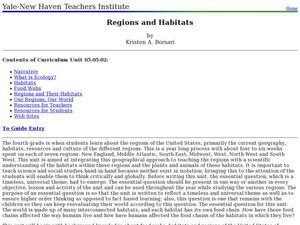Curated OER
Discover a Pond Food Web
Students study the biodiversity of animal life in a pond. They investigate the interdependence between pond organisms by completing a pond dipping activity and completing a checklist.
Curated OER
Tracing the History Of Food
Students explore cultural variations in food preparation. They pick a country and research dishes of cultural significance. They prepare their food and present the dish to the class creatively.
Curated OER
Owls are a Hoot!
Students construct a food web based on the animals found inside owl pellets. For this owls lesson plan, students research and describe the characteristics of owls as well.
Curated OER
Globalization Comes to the Table
Students, in groups, research the issues surrounding one of several controversies involving food and globalization. Then they debate their position and show a PowerPoint presentation at a mock summit meeting.
Curated OER
Food Chains
Students investigate how food chains work. In this food chains lesson, students construct a food web for a pear tree habitat. The interactive whiteboard is an optional tool in this lesson.
Eastern Michigan University
Energy Flow in a Wetland Ecosystem
How is energy transferred within an ecosystem? What would happen to a food web if one of the organisms was removed? Elementary or middle school ecologists examine these questions and more in a comprehensive 5E learning cycle lesson....
MENSA Education & Research Foundation
Ecosystems
Explore the Earth's different ecosystems through four lessons, an assessment, and extension activities. Lessons include informative text and step-by-step instructions to apply knowledge in interactive, and thought provoking ways; such as...
Howard Hughes Medical Institute
Lesson 5: Tracking Lion Communities
Researchers in Gorongosa National Park placed cameras there many years ago to understand what was happening with the lion communities that lived there. Little did they know, they opened a door to so much more! Inquisitive...
NOAA
Deep-Sea Ecosystems – Life is Weird!
A pool of brine in the deep sea can be up to four times as salty as the surrounding sea water. The deep sea ecosystem relies on chemosynthesis and the organisms that live there are often strange to us. The lesson focuses on researching...
Curated OER
Food Webs
High schoolers are explained that they are spending the next few days researching an organism in preparation for a field trip. They are shown an overhead of the Field Guide. Students discuss what habitat means. They use their organism...
Curated OER
Getting Food
Learners complete activities to learn about the ocean food web. In this ocean life lesson, students discuss how the tides affect feeding, learn about filter feeders, grazers, predators, and scavengers. Learners then group the animals...
Curated OER
Habitats
Students complete food chains for organisms in three environments. They use copies of the Habitat worksheet. Students review the food chain terms with the teacher. They research related food chains, and interlink these to form a food...
Curated OER
Interdependence and Adaptation
Fifth graders construct a food web to illustrate how animals and plants are interdependent. In this interdependence lesson, 5th graders identify how consumers, producers, herbivores, carnivores and predators are related in a habitat....
Curated OER
Circle of Life
Students consider why we eat and where our food obtains its energy. They illustrate food chains that might be found on an open field, dissect owl pellets, identify the remains of animals in the pellets, watch videos and participate in...
Curated OER
Vocabulary: Kansas Prairies
Students explore the ecosystem by reviewing scientific vocabulary terms. In this environmental awareness activity, students identify the differences between abiotic and biotic factors and their relationship to the Earth. Students define...
Curated OER
Plankton
Students explore the attributes of plankton. In this plankton lesson, students read This is the Sea That Feeds Us and discuss food chains. Students discover the differences between phytoplankton and zooplankton as they examine the...
Curated OER
Carmaleetas
Students identify the relationship between predator and prey in the food chain. In this food chain lesson plan, students work in groups and play a predator and prey game. Students discover what happens when a predator does not find prey.
Curated OER
Food Chains and Webs--- "What's for dinner?"
Students study food chains and how the organisms are linked. In this investigative learning exercise students answer food chain questions, and fill out several worksheets.
Curated OER
Fast Food: You Can Choose!
Learners research the nutritional value of fast food. They assess which fast foods are best and worst to eat. They organize their data into tables and graphs and explain their findings to other students.
Curated OER
What's for Dinner?
Students investigate the dietary habits of living organisms by creating a model food chain. In this food web lesson, students define several food chain vocabulary words such as omnivore, carnivore and herbivore. Students utilize...
Curated OER
The Food Pyramid
Students determine that humans need food to function properly. In this nutrition lesson plan, students discuss the food categories used in the food pyramid by charting the foods eaten in one day.
NASA
Consumers Get Energy From Other Living Things
How do plants and animals get their food? Learn about where energy comes from, how animals store energy, and aerobic respiration, in a instructional activity that allows scholars to diagram energy flows.
Forest Foundation
The Web of Life
Producers, herbivores, carnivores, omnivores, decomposers. To begin a study of the forest ecosystem, learners examine the connections among the members of ecological communities.
Curated OER
Regions and Habitats
Fourth graders identify the different habitats found in the seven regions of the United States. In this ecology lesson, 4th graders write an essay about how humans affect the ecosystem and vice versa. They discuss how changes on one...







